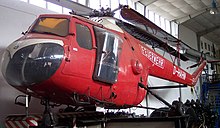Bristol Sycamore
| Bristol 171 Sycamore | |
|---|---|
 Bristol 171 Sycamore |
|
| Type: | Rescue helicopter |
| Design country: | |
| Manufacturer: | |
| First flight: |
July 27, 1947 |
| Commissioning: |
1953 |
| Production time: |
1947 to 1959 |
| Number of pieces: |
178 |
The Bristol 171 Sycamore is a British five-seat helicopter . It is the first helicopter built in the UK after World War II .
History and use
During the Second World War , after the invasion of France by the Allied forces in the summer of 1944, numerous engineers who had previously worked on cargo sailing projects became available again. The Bristol Airplane Company was able to draw on these resources and began developing a new type of helicopter. After more than two years of the development and construction phase, in which special attention was paid to the durability of the technical components, the Sycamore prototype was ready and was able to take off on July 27, 1947 for the first flight .
In the course of series production, however, some changes were made. The cabin was widened so that there was space for three passengers behind the pilots. The cabin structure was stiffened in order to be able to mount a cable winch and the main rotor was designed so that it could be folded in (see picture on the right).
From February 1952 to 1959, a total of 178 aircraft were manufactured for the Royal Air Force , the German Federal Armed Forces , the Belgian Armed Forces and the Royal Australian Air Force as well as for the civilian users British European Airways and Ansett Australia .
The Bundeswehr received 50 Sycamore MK 52 G machines , of which the first helicopters were delivered to the Air Force from May 1957 . From June 1958 a total of 10 helicopters were delivered to the naval aviation . From January 1967, the Navy gave the helicopters to the Air Force. Two years later, the Sycamore's service with the German Armed Forces ended.
construction
The machine is made entirely of metal, has a non-retractable three-leg chassis and has the conventional main rotor - tail rotor design. Both rotors have three blades each. The Bristol 171 was the first helicopter to be entirely designed and built in the UK.
While the prototype was still equipped with a Pratt & Whitney R-985 engine, the new and more powerful Alvis-Leonides radial engine was used in the second machine built . This engine should be used as standard in all other Sycamores built .
Military use
Technical specifications
| Parameter | Data Sycamore 52 |
|---|---|
| length | 14.10 m |
| height | 4.49 m |
| width | 3.40 m |
| Rotor diameter | 14.80 m |
| Empty mass | 1850 kg |
| Takeoff mass | 2500 kg |
| Engine | 1 × 9-cylinder radial engine Alvis Leonides MK 17 3102 with 410 kW |
| Top speed | 212 km / h |
| Cruising speed | 160 km / h |
| Service ceiling | 4800 m |
| Range | 531 km |
Whereabouts
The Flying Bulls Red Bull a copy was airworthy restored 2010-2013. It is the ex. D-HALD. It is approved in Austria with the OE-XSY mark.
Trivia
A Bristol 171 can be seen in the American film "With the Wind to the West" (1980) as the pseudo Mi-1. She can also be seen in the Tatort episode Kielwasser with Götz George as Inspector Schimanski (1983). It was the machine with the aircraft registration D-HALC. The D-HALC was completely destroyed in an engine fire in 1986. But in 1987 another Bristol 171 was approved; the D-HALD. In 1988 the D-HALD and in 1989 the ex. D-HELM, with Swiss approval HB-RXA, transferred by air to Eastern Switzerland. This ends the commercial Sycamore era in Germany.
See also
literature
- CH Barnes: Bristol aircraft since 1910. Putnam, 1964, ISBN 0-85177-823-2 .
- Chaz Bowyer: The Encyclopedia of British Military Aircraft. Bison Books Limited, ISBN 0-86124-258-0 .
- Leonard Bridgman: Jane's All The World's Aircraft 1951-1952. Samson Low, Marston & Company Ltd, London 1951.
Web links
- Production list ( Memento from March 6, 2012 in the Internet Archive )


